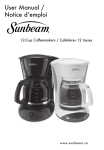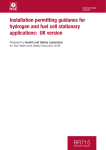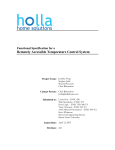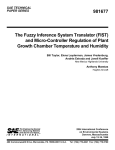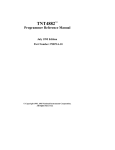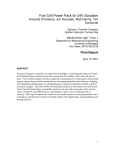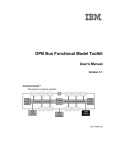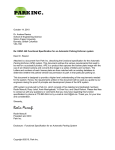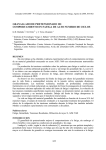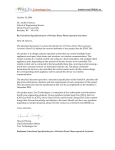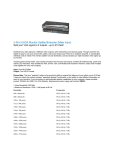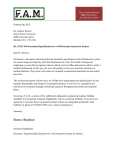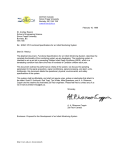Download February 22, 2005 Mr. Lucky One School of Engineering Science
Transcript
8888 University Drive Burnaby, BC Canada V5A 1S6 [email protected] www.mfclabs.com small innovations for big solutions™ February 22, 2005 Mr. Lucky One School of Engineering Science Simon Fraser University Burnaby, British Columbia V5A 1S6 Re: ENSC 440 Functional Specifications for a Micro Fuel Cell Testbench Dear Mr. One: Please find attached the document, Functional Specifications for a Micro Fuel Cell Testbench, outlining the functionality of our product for ENSC 440. The purpose of the product is to allow a researcher to perform rigorous testing on his or her design of a novel micro fuel cell. The testbench shall perform real-time data acquisition of the micro fuel cell operating parameters and shall be capable of operating as a stand-alone system which can be used to demonstrate the micro fuel cell for consumers and potential investors. The attached document outlines in detail the required functionality of the prototype and additional features for future versions of the product. The functional requirements are discussed for the system as a whole and for its components separately. The document also provides information on requirements for the user as well as safety and regulatory requirements for our product. Our team includes four talented individuals with expertise in various technical fields. The members of our team are Arash Jamshidi, Sarang Toosi, Olha Lui, and Shirin Farrahi. Please feel free to contact us at by e-mail at [email protected] for more information regarding our project. Sincerely, Shirin Farrahi Shirin Farrahi Chief Executive Officer (CEO) Micro Fuel Cell Labs (MFC Labs) Enclosure: Functional Specifications for a Micro Fuel Cell Testbench Functional Specifications for a Micro Fuel Cell Testbench Project Team Arash Jamshidi Olha Lui Sarang Toosi Shirin Farrahi Contact person Shirin Farrahi [email protected] Submitted to Lucky One – ENSC 440 Mike Sjoerdsma – ENSC 305 School of Engineering Science Simon Fraser University Date: February 22, 2005 ``` Executive Summary MFC Labs recognizes the increasing need for convenient, long-lasting power for portable electronics equipment. Our company believes that micro fuel cell technology shows great potential for solving many of the problems with current portable power solutions including weight, recharging requirements, and lifetime. Our product, the MFC Testbench, is meant to address fuel cell researchers’ need for a cheap and portable device for testing micro fuel cells. The MFC Testbench will allow for accurate and exhaustive characterization of a micro fuel cell’s characteristics while also being a useful tool for demonstrating the fuel cell’s operation to potential investors at tradeshows. The prototype of our product will be completed by the end of April 2005 and will immediately be put into use for testing the micro fuel cell developed by the National Research Council of Canada’s (NRC) Institute for Fuel Cell Innovation (IFCI). To be useful and competitive to current test equipment on the market, the MFC Testbench must meet a number of functional requirements. In our functional specifications we outline these requirements including 1. The capability to use power from a battery or AC adaptor. 2. The ability to log test data to a computer via a graphical user interface. 3. The ability to vary the load seen by the fuel cell manually and using a computer. In addition, we have outlined requirements for the accuracies and ranges of current, voltage, temperature, and humidity measurements available from our test station; the reliability of our unit; and the portability and ease of use offered. We also specify our expectations of the user as well as safety and regulatory requirements which must be upheld by our design and by the users. In addition to specifying requirements for the development of the prototype, the functional specifications also specify requirements for the next stage of the project including 1. A rechargeable battery source. 2. Enhanced user functions offered by the graphical user interface program. 3. Flow monitoring and control equipment to regulate the supply of methanol to the device under test (DUT). The functional specifications presented will serve as an agreement with our customers on the functionality of our product and as a guide for the MFC Labs team in product design and development. Copyright © 2005 MFC Labs ii ``` Table of Contents EXECUTIVE SUMMARY ......................................................................................................................... II TABLE OF CONTENTS ...........................................................................................................................III TABLE OF FIGURES ...............................................................................................................................III GLOSSARY ................................................................................................................................................ IV 1. INTRODUCTION .................................................................................................................................... 1 1.1 Scope......................................................................................................................... 1 1.2 Objective ................................................................................................................... 1 2. SYSTEM REQUIREMENTS.................................................................................................................. 2 2.1 System Overview ...................................................................................................... 2 2.2 Physical Requirements.............................................................................................. 3 2.3 System Requirements................................................................................................ 3 2.3.1 General ........................................................................................................................................ 4 2.3.2 Ranges and Accuracies of Controls and Measurements .............................................................. 4 2.3.3 Performance................................................................................................................................. 5 2.3.3 Power ........................................................................................................................................... 5 2.3.5 Reliability..................................................................................................................................... 5 2.4 User Expectations ..................................................................................................... 6 3. INTERFACE REQUIREMENTS........................................................................................................... 7 3.1 Onboard Interface Requirements .............................................................................. 7 3.1.1 General ........................................................................................................................................ 7 3.1.2 Onboard Display Requirements................................................................................................... 8 3.2 Graphical User Interface Requirements.................................................................... 8 3.2.1 Load Cycle File Requirements ..................................................................................................... 9 3.2.2 Data Logging Requirements ........................................................................................................ 9 3.4 DUT Interface Requirements.................................................................................. 10 4. REGULATORY REQUIREMENTS.................................................................................................... 10 5. DOCUMENTATION AND USER TRAINING................................................................................... 11 6. CONCLUSION....................................................................................................................................... 12 7. REFERENCES ....................................................................................................................................... 13 Table of Figures FIGURE 1: GRAPHICAL REPRESENTATION OF MFC TESTBENCH SYSTEM BLOCKS [1]..................................... 2 FIGURE 2: FUNCTIONAL DIAGRAM OF ONBOARD DISPLAY CONTROL BUTTON ............................................... 7 Copyright © 2005 MFC Labs iii ``` Glossary AC DMFC DUT GUI MFC Testbench MSDS Alternating Current Direct Methanol Fuel Cell Device Under Test Graphical User Interface Micro Fuel Cell Testbench Material Safety Data Sheet Copyright © 2005 MFC Labs iv ``` 1. Introduction The Micro Fuel Cell Testbench is a product in development that is intended for use in the laboratory environment for rigorous testing of novel direct methanol fuel cells (DMFCs). Additionally, the MFC Testbench will be able to operate as a stand-alone unit during tradeshows. The main testing operations of the device will include monitoring the operating voltage and current of the DMFC in response to variable load. The unit will also monitor the ambient temperature and humidity while the fuel cell is operating. The prototype of the MFC Testbench is currently under development with the intent of being tested in a laboratory environment by April 2005. 1.1 Scope This document provides detailed functional specifications for the prototype of the MFC Testbench, as well as additional specifications intended for future versions of the product. The functionality of the testbench is discussed for the system as a whole, as well as for its components. In addition, separate sections address the expectations of the user of the testbench, safety and regulatory requirements, and documentation and user training. 1.2 Objective The requirements listed in this document are intended to outline the functional specifications of the MFC Testbench to the potential users, as well as to guide the design of the testbench. The following convention is used throughout this document to denote functional requirements: R[#]-P Functional specifications requirement #: Requirement Number P: Priority of Requirement. P can have one of the following values: A – denotes a high priority requirement to be implemented for the proof of concept device B – denotes an enhanced feature to be implemented for the productionready device. Copyright © 2005 MFC Labs 1 ``` 2. System Requirements 2.1 System Overview The main function of the MFC Testbench is to provide a stand-alone, portable, durable, accurate and easy-to-use measurement system that can help researchers demonstrate their micro fuel cell in tradeshows. In addition, the system can be used to characterize the voltage, current, temperature, and humidity operating parameters of a DMFC for many hours. Figure 1 shows a graphical representation of the MFC Testbench functional blocks. Power Management Control Software To internal circuitry Onboard Display Micro Controller Measurement Variable Load Device Under Test (DUT) Figure 1: Graphical Representation of MFC Testbench System Blocks [1] The micro fuel cell developed by Kevin Stanley’s group at the Institute for Fuel Cell Innovation is shown in Figure 1. This fuel cell will be connected to our testbench and supplied with a 5% solution of methanol fuel. The MFC Testbench can be controlled by a graphical user interface (GUI) which can both log test data for the fuel cell and control the value of the variable load. The micro fuel cell operating data will also be shown on the testbench display as it is acquired through the measurement block. In addition, there will be a variable load connected to the DUT which will allow researchers to test the DMFC under various load conditions. Copyright © 2005 MFC Labs 2 ``` 2.2 Physical Requirements The main physical requirements of the MFC Testbench are that it be portable, imposing restrictions on its weight, size, and connectivity requirements. R[1]-A The testbench without the fuel cell, methanol supply, and electronic load shall be no larger than 20cm x 10cm x 5cm. R[2]-A The testbench without the fuel cell, methanol supply, and electronic load shall weigh no more than 3 kg. R[3]-A The testbench shall be suitable for safe transportation and easy assembly at tradeshows (see sections 3 and 4 for more detailed specifications on interface requirements and safety). R[4]-A The testbench shall be stand-alone and capable of operating without a computer connection. R[5]-A The testbench shall be divided in two separate sections: fuel cell unit and measurement unit. R[6]-A The user shall have open access to the DUT for easy transferring during testing and for visibility of the DUT during demonstrations. R[7]-A The onboard display shall be mounted on top of the testbench. R[8]-A The manual load control knob shall be accessible from the top of the testbench. R[9]-A The power jack, battery, and port for communication with the computer shall be easily accessible. R[10]-A The humidity and temperature monitoring equipment shall be located within 2 cm of the cathode of the DUT. 2.3 System Requirements The MFC Testbench is intended for use in research and development; therefore, its main requirements govern the accuracy of the controls and measurements which it can provide and the reliability of the unit. Copyright © 2005 MFC Labs 3 ``` 2.3.1 General R[11]-A The testbench shall be capable of operating at temperatures between 0 to 40 ºC. R[12]-A The testbench shall be equipped with two resistive loads: one manually controlled and one controlled by the GUI. R[13]-B A transient load analysis shall be provided for more rigorous testing of the DUT. R[14]-B The testbench shall have an onboard storage capability for storing data of up to 50 kB. 2.3.2 Ranges and Accuracies of Controls and Measurements The MFC Testbench must measure the current, voltage, temperature, and humidity of the operating fuel cell with a specified accuracy. Similarly, the testbench should be capable of controlling the manual and electronic load values in a specified range. R[15]-A The tesbench shall provide the capability to test DUT operating voltages of up to 2.00 V ± 0.05 [2]. R[16]-A The testbench shall be capable of varying the electronic computercontrolled resistive load bank in the range of 1 Ω to 1 kΩ when used in the constant resistance mode, with a maximum power dissipation of 1 W. R[17]-A The manual variable load shall be capable of varying in the range of 1 Ω to 50 kΩ, where 0.5 W is the maximum power dissipation. R[18]-A The maximum current flowing through the load shall be 1 A [3]. R[19]-A The testbench shall be capable of detecting and displaying humidity in the range of 1 to 90 % RH ± 3 based on the ambient humidity of the environment [2]. R[20]-A The testbench shall be capable of detecting and displaying temperatures in the range of 0 to 100 ºC ± 1 [2]. R[21]-B The flow rate monitoring equipment shall be capable of operating in the range of 20 - 100 mL/min with an accuracy of 10% full scale. Copyright © 2005 MFC Labs 4 ``` 2.3.3 Performance R[22]-A The response time of the onboard display to changes in the voltage, current, humidity and temperature sensors shall have an upper limit of 500 ms. R[23]-A The response time of the onboard display to display control commands shall have an upper limit of 1 s. R[24]-A The response time of the GUI program to the user pressing the “Exit” button shall be less than 1 s. 2.3.3 Power To ensure portability and convenience of the MFC Testbench, it shall have the option of being powered from a portable AC adaptor or from a battery. R[25]-A The testbench shall be capable of being powered by a 110 V, 60 Hz AC adaptor which can operate in the range 0 to 50 ºC. R[26]-A The onboard battery shall be capable of operating in the range 0 to 40 ºC. R[27]-A The battery shall be capable of powering the testbench for a minimum of eight (8) hours continuously. R[28]-B The battery shall be rechargeable. 2.3.5 Reliability The MFC Testbench is required for long-term, unsupervised testing of the DMFC; therefore, the unit must be capable of operating without failure over long periods of time. R[29]-A When powered by the AC adaptor, the unit must be capable of monitoring the DUT’s operating voltage, current, temperature, and humidity for up to 720 hours (30 days) without failing. R[30]-A If the user interface program detects a current, voltage, temperature, or humidity outside of the ranges specified in section 2.3.2, a warning message will be displayed, and the test cycle will terminate. R[31]-A If the load value specified in a row of the Load Cycle file is outside of the range specified in section 2.3.2, the user interface program shall display a warning message and end the current test cycle. Copyright © 2005 MFC Labs 5 ``` R[32]-B If the onboard controller detects a current, voltage, temperature, or humidity reading outside of the ranges specified in section 2.3.2, a warning message will be displayed, and the controller will stop taking measurements. R[33]-A The testbench must be able to recover from a potential failure if the user resets the unit using the power switch. R[34]-A The testbench shall have a mean time between failures (MTBF) of at least 50,000 hours. R[35]-A The testbench shall be serviceable by the end user. R[36]-A The onboard display control switch shall have a duty cycle of 200,000 cycles for each direction [1]. R[37]-A The onboard power switch and load toggling switch shall have a duty cycle of 100,000 cycles each. 2.4 User Expectations Due to the dependence of the MFC Testbench operation on the user’s fuel cell, a large number of requirements are placed on the user in order to operate the unit properly. R[38]-A The user shall provide a 5 % methanol-water solution housed in a pressurized tank and tubing to supply the methanol to the DUT. R[39]-A The user shall provide the necessary enclosures, connectors, tubing, and supply tank for the fuel cell and methanol fuel supply. R[40]-A The user shall provide the tubing for the waste outlets of the DUT and the waste collecting containers. R[41]-A The user shall be responsible for the safe disposal of the waste (see section 4 for more detailed safety requirements). R[42]-A The user shall be responsible for recording flow rates of interest during the operation of the testbench. R[43]-A The user shall be responsible for arranging the means for controlling the rate of fluid flow. R[44]-A The user shall supply a computer capable of running the user interface program and storing a data cycle file of up to 128 MB in capacity. Copyright © 2005 MFC Labs 6 ``` 3. Interface Requirements 3.1 Onboard Interface Requirements The MFC Testbench onboard interface shall include two switches, a display, a joystick button to control the display, and a dial for controlling load values. 3.1.1 General R[45]-A The testbench shall have an on/off power switch. R[46]-A There shall be a single onboard button to allow the user to toggle between the DUT operating display options. R[47]-A The onboard button will allow the user to scroll through the menu options in four directions or select an option by pressing down on it as shown in Figure 2. Figure 2: Functional Diagram of Onboard Display Control Button R[48]-A The onboard manual load control will allow the user to vary the load using a rotary dial. R[49]-A There shall be an onboard switch to allow the user to switch between manual and computer-controlled load. R[50]-A The user shall have to turn off the testbench’s power before switching between manual and computer-controlled load then power up the system again before the change takes effect. R[51]-B Flow rate monitoring equipment shall provide a visual means of monitoring the flow rate of methanol to the DUT. Copyright © 2005 MFC Labs 7 ``` 3.1.2 Onboard Display Requirements The onboard display shall provide the user with a single-line display to view the operating parameters of the DUT including absolute time and date, voltage, current, temperature, and humidity values. The ranges and accuracies of these display values are outlined in section 2.3.2. When the MFC Testbench is turned on, the user will be able to scroll through the display options menu as described below. R[52]-A The top level of the menu shall display a welcome message. The lower levels of the menu shall allow the user to view the DUT’s operating parameters. R[53]-A The date and time level of the menu shall allow the user to scroll between the current time and current date. R[54]-A Current time will be displayed in the format “hh:mm:ss”. Current date will displayed in the format “dd:mm:yy”. R[55]-A The date and time level of the menu shall allow the user to adjust the current time and current date settings using the onboard button. R[56]-A The voltage level of the display menu shall display the voltage in the format “3V25” where the symbol “V” represents the decimal point position. R[57]-A The current level of the display menu shall display the current in the format “100mA” where the symbol “mA” shall display the decimal point position. R[58]-A The humidity level of the display menu shall display the humidity in the format “20RH” where “RH” means percentage of the relative humidity. R[59]-A The temperature level of the display menu shall display the temperature in the format “+24°C”/”+75°F” where the user can toggle between Celsius and Fahrenheit units. 3.2 Graphical User Interface Requirements The Graphical User Interface will present the user with controls and indicators for controlling the MFC Testbench remotely and logging test data automatically. R[60]-A The user shall have the option of exiting the program at any point of its operation by pressing a button. R[61]-A The user shall be presented with dedicated buttons for beginning or ending a test cycle. Copyright © 2005 MFC Labs 8 ``` R[62]-B The user shall be presented with a button allowing him or her to pause/resume a test cycle. R[63]-A After choosing to start a test cycle, the user shall be able to choose whether or not to enter a pre-determined Load Cycle file. R[64]-A If the user begins a test cycle without entering a Load Cycle file, the user interface program will log data without modifying the load seen by the fuel cell. R[65]-B If the user begins a test cycle without entering a Load Cycle file, he or she will be able to vary the load manually on the testbench. R[66]-B In the case where a Load Cycle file is not entered, the user shall have the ability to control the load interactively using a virtual dial control in the control software. 3.2.1 Load Cycle File Requirements R[67]-A The user shall be able to browse the computer’s existing files from the GUI program to find the desired Load Cycle file. R[68]-A The Load Cycle file shall contain as many rows as the distinct loads that the user wants to apply to the fuel cell. R[69]-A Each row in the Load Cycle file shall contain two columns, one specifying the load value, and one specifying the duration of time for which the load should be applied. 3.2.2 Data Logging Requirements When a test cycle is initiated, the DUT operating parameters (current, voltage, temperature, humidity) will be obtained periodically by the user interface program. R[70]-A The shortest time interval between consecutive data samples by the user interface program shall be 10 s. R[71]-B The user shall be able to vary the period of data uploading by entering a value between 10 s and 1 hour as the test cycle is operating. R[72]-A The ten (10) most recent data instances shall be displayed in a table on the computer screen. R[73]-A All data instances shall be stored in a Data Log file. Copyright © 2005 MFC Labs 9 ``` R[74]-A The Data Log file shall have one row for each data instance. R[75]-A Each row in the Data Log file shall consist of seven (7) columns: absolute date, absolute time, time since beginning of test cycle, operating current, operating voltage, operating temperature, and operating humidity. 3.4 DUT Interface Requirements The DUT shall be fueled by a methanol-water solution and air. Refer to section 2.4 for more details regarding the equipment supplying the fuels. R[76]-A The fuel cell and measurement sections of the MFC Testbench shall be connected through a protected electrical interface. R[77]-B Flow rate monitoring equipment shall be incorporated in the line of flow of the methanol. R[78]-B The flow rate monitoring equipment shall have fluid touching parts and outlet tubing which are chemically inert to the 5% methanol-water solution. R[79]-B The flow rate monitoring equipment shall be able to operate at fluid temperatures of up to 35 ºC at 0 pressure. R[80]-B The flow rate monitoring equipment and the tubing shall be able to operate at a maximum fluid pressure of 75 psig at 21 ºC. R[81]-B The flow rate monitoring equipment and the tubing shall be capable of operating with fluid containing debris of up to 50 microns in size. 4. Regulatory Requirements The safety and regulatory requirement for the MFC Testbench address the issues related to methanol handling, the fuel cell operation, and the electronic components. R[82]-A The testbench shall operate within the Safety Requirements for Electrical Equipment for Measurement in Control and Laboratory Use [4]. R[83]-A The testbench shall operate within the safety standards established by CSA International Requirement No. 3.01 for Portable Fuel Cell Appliances [5]. R[84]-A The testbench shall operate within the safety standards established by ANSI/CSA America FC 1-2004, Stationary Fuel Cell Power Systems, where they deal with methanol [6]. Copyright © 2005 MFC Labs 10 ``` R[85]-A The testbench fluidic handling parts shall exclude materials which are chemically reactive with methanol, as advised by its Material Safety Data Sheet (MSDS) [7]. R[86]-A The user shall transport the DUT and methanol handling equipment according to the safety standards established by the Canadian DTG: Methanol, Flammable Liquid [8]. R[87]-A The user shall handle the DUT and methanol according to the safety standards and recommendations established by WHMIS-Canada and the Canada Safety Council [8], [10]. R[88]-A The user shall educate himself on issues related to DMFC safety standards currently in development, such as USA (CSA FC 3) Portable Fuel Cell Power Systems and Canada Portable Fuel Cell Standard [9]. R[89]-A The testbench unit shall be safely constructed without any sharp or fragile parts. R[90]-A The electronic parts of the testbench shall be separated from the methanol handling parts where it does not contradict with functionality. 5. Documentation and User Training The intended user for the MFC Testbench is a researcher who is working on a direct methanol fuel cell. It is expected that the user has sufficient technical background and skills to set up the testbench with the DUT, perform the test, and interpret the results. R[91]-A The documentation for the product will consist of one user manual in English. R[92]-A The user manual will have information on functionality of the device, operating conditions, instructions for interfacing the device to the DUT, methanol supply, requirements for the user’s computer, and a set of sample test instructions. R[93]-A The user manual will provide suggestions on how to expand the hardware components and how to upgrade the software of the product. R[94]-A The user manual will also include a troubleshooting section and a safety section. R[95]-A The company’s website, www.mfclabs.com, shall be a source of brief technical information about the product, downloadable whitesheets, and FAQ information on the functionality and operation of the device. Copyright © 2005 MFC Labs 11 ``` R[96]-A Training for the end users will be provided via the user manual and by contacting the technical support by e-mail at [email protected]. R[97]-A The users of the prototype version of the product will meet with the project developers for initial training on interfacing the DUT to the testbench and on testing the DUT. 6. Conclusion The functional specifications outlined in this document are detailed and demanding. We have created this challenge for ourselves intentionally to ensure we can meet the high demands of researchers in the field of micro fuel cells, and to push ourselves to develop a product that will set a new standard for cheap, reliable, and portable DMFC test equipment. The specifications for the system and its components will allow us to design an expandable testbench and to allocate our time and resources efficiently. We intend to develop the functionality identified as required for the prototype by the end of April 2005. Copyright © 2005 MFC Labs 12 ``` 7. References [1] Atmel Corporation Products, 2005, “AVR Butterfly”, 23 January 2005 <http://www.atmel.com/dyn/products/tools_card.asp?tool_id=3146> [2] Niroumand, A. “Micro Direct Methanol Fuel Cell Test Station” Dec. 2004. [3] Stanley, K.; Czyzewska, E. et. al. “A Novel Fabrication Method for Micro Fuel Cells.” [4] “Safety Requirements for Electrical Equipment for Measurement, Control, and Laboratory Use” CAN/CSA-C22.2 NO. 61010-1-04 Canadian Standards Association, 2001. Accessed on February 21, 2005 at <http://www.csa.ca/electronic_catalogue/electrical.pdf> [5] “International Requirement No. 3.01 For Portable Fuel Cell Appliances.” Canadian Standard Association, August 2001. Accessed on February 19, 2005 at <http://www.fuelcellstandards.com/2.1.3.13.htm>. [6] “Stationary Fuel Cell Power Systems.” ANSI/CSA America FC, February 2004. Accessed on February 19. 2005 at <http://www.fuelcellstandards.com/2.1.3.1.htm> [7] “Material Safety Data Sheet for Methanol” Methanex Corporation, Dec. 10, 2002. Accessed on February 21, 2005 at <http://www.methanex.com/products/documents/MSDS_CANenglish.pdf>. [8] “Technical and Safety Data for Methanol.” Methanex Corporation. Accessed on February 21, 2005 at <http://www.methanex.com/products/technical.html>. [9] “Portable Fuel Cell Power Systems and Canada Portable Fuel Cell Standard.” CSA FC 3. Canadian Standards Association. Accessed on February 21, 2005 at <http://www.fuelcellstandards.com/2.1.3.3.htm>. [10] “Methanol” Canada Safety Council, 2004. Accessed on February 21, 2005 at <http://www.safety-council.org/info/OSH/methanol.htm>. Copyright © 2005 MFC Labs 13


















